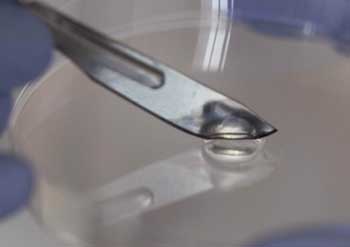| Jul 25, 2019 |
Bacteria-killing gel heals itself while healing you
|
|
(Nanowerk News) McMaster researchers have developed a novel new gel made entirely from bacteria-killing viruses.
|
|
The anti-bacterial gel, which can be targeted to attack specific forms of bacteria, holds promise for numerous beneficial applications in medicine and environmental protection.
|
|
Among many possibilities, it could be used as an antibacterial coating for implants and artificial joints, as a sterile growth scaffold for human tissue, or in environmental cleanup operations, says chemical engineer Zeinab Hosseini-Doust.
|
|
Her lab, which specializes in developing engineering solutions for infectious disease, grew, extracted and packed together so many of the viruses - called bacteriophages, or simply phages - that they assembled themselves spontaneously into liquid crystals and, with the help of a chemical binder, formed into a gelatin-like substance that can heal itself when cut.
|
|
Yellow in colour and resembling Jell-O, a single millilitre of the antibacterial gel contains 300 trillion phages, which are the most numerous organisms on Earth, outnumbering all other organisms combined, including bacteria.
|
 |
| McMaster engineers specializing in infectious diseases have created a bacteria-killing gel composed entirely of friendly viruses. The gel can heal itself when cut. (Image: JD Howell, McMaster University)
|
|
"Phages are all around us, including inside our bodies," explains Hosseini-Doust. "Phages are bacteria's natural predators. Wherever there are bacteria, there are phages. What is unique here is the concentration we were able to achieve in the lab, to create a solid material."
|
|
The field of phage research is growing rapidly, especially as the threat of antimicrobial resistance grows.
|
|
"We need new ways to kill bacteria, and bacteriophages are one of the promising alternatives," says Lei Tan, a PhD student in Hosseini-Doust's lab and a co-author on the paper describing the research, published in the journal Chemistry of Materials ("Hierarchically Structured, Self-Healing, Fluorescent, Bioactive Hydrogels with Self-Organizing Bundles of Phage Nanofilaments"). "Phages can kill bacteria that are resistant to antibiotics."
|
|
Hosseini-Doust says the DNA of phages can readily be modified to target specific cells, including cancer cells. Through a Nobel Prize-winning technology called phage display, it's even possible to find phages that target plastics or environmental pollutants.
|
|
Being able to shape phages into solid form opens new vistas of possibility, just as their utility in fighting diseases is being realized, she says.
|

